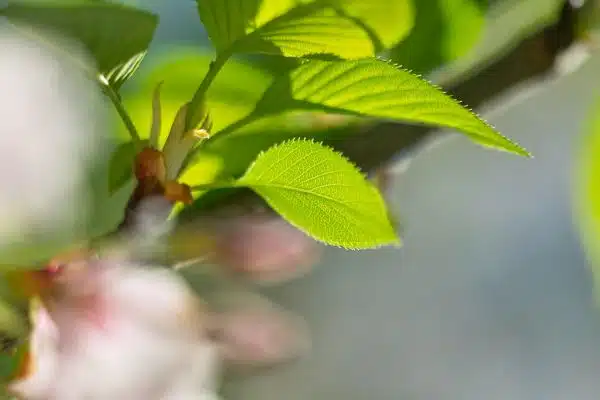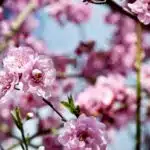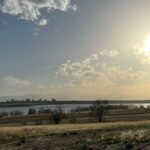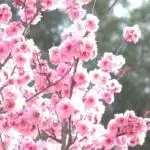Yoshino cherry trees, also known as Prunus × yedoensis, are a popular ornamental tree species that can add beauty and elegance to any landscape. These trees are native to Japan and are famous for their stunning pink and white blossoms that emerge in early spring, making them one of the most beloved symbols of the season. Growing Yoshino cherry trees requires careful planning and attention to detail, but with the right techniques, anyone can successfully cultivate these lovely trees.
In this article, we will provide you with a comprehensive guide on how to grow Yoshino cherry trees successfully. We will discuss everything from selecting the right location for planting to proper pruning techniques and pest control measures. Whether you are a seasoned horticulturalist or a beginner gardener looking to add some beauty to your outdoor space, our guide will provide you with all the information you need to grow healthy and vibrant Yoshino cherry trees that will delight your senses and those of others who appreciate nature’s beauty.
Overview Of Yoshino Cherry Trees
The Yoshino cherry tree, also known as Prunus × yedoensis, is a beautiful and popular ornamental tree that blooms in early spring. Its delicate pink or white flowers are a symbol of renewal and hope, and have become an important part of many cultures around the world. In Japan, the cherry blossom season is celebrated with festivals and picnics under the trees, while in the United States, cities like Washington D.C. and Macon, Georgia hold annual Cherry Blossom Festivals to honor these stunning trees.
To grow a healthy Yoshino cherry tree, it is essential to select the right location for planting. These trees prefer full sun or partial shade and well-drained soil that is rich in organic matter. They also need enough space to spread their roots and grow to their full size, which can range from 20-40 feet tall depending on the cultivar. It’s important to research your specific climate zone before choosing a spot for your tree, as they thrive in USDA zones 5-8.
When planting your Yoshino cherry tree, make sure to dig a hole that is at least twice as wide as the root ball but no deeper than the top of the root ball. This will allow for good drainage and prevent water from pooling around the roots. Once you’ve planted your tree, it’s important to keep it well-watered during its first growing season so that it can establish itself properly in its new location.
Selecting The Right Location
Site selection is a crucial factor in growing healthy and productive Yoshino cherry trees. The ideal location for these trees should be an area that receives full sun exposure for at least six hours every day. This amount of sunlight allows the tree to develop properly, producing large clusters of pinkish-white flowers in the spring.
Environmental factors should also be taken into consideration when selecting a site for planting Yoshino cherry trees. Avoid areas with strong winds or heavy foot traffic as they can damage the delicate branches and roots of the tree. Additionally, ensure the soil is well-drained to prevent waterlogging, which can cause root rot.
To further emphasize the importance of selecting the right location for your Yoshino cherry tree, consider the following:
- Choose a location with good air circulation to reduce fungal diseases.
- Avoid planting near buildings or structures that block sunlight.
- Select an area away from standing water, which can attract pests and diseases.
By considering these factors during site selection, you can provide an optimal environment for your Yoshino cherry tree to thrive and produce beautiful blooms year after year. In the next section, we will discuss how to prepare your soil for planting these trees effectively.
Soil Preparation
- Prunus × yedoensis, commonly known as the Yoshino cherry tree, is a popular ornamental and flowering tree.
- When planting Yoshino cherry trees, it is important to consider soil pH, drainage, and fertility in order to ensure the tree’s health and growth.
- Soil pH should be adjusted to a slightly acidic range of 6.0-7.0 in order to provide the optimal environment for the Yoshino cherry tree.
- Good soil drainage is also essential, as Yoshino cherry trees are not tolerant of water-logged soils.
- Soil fertility should be taken into account before planting, as the Yoshino cherry tree requires adequate amounts of nitrogen, phosphorus, and potassium.
- Compost, manure, and other organic matter should be incorporated into the soil to ensure the best possible growth for the Yoshino cherry tree.
Soil Ph
Acquiring a healthy soil pH level is critical in growing Yoshino cherry trees (Prunus × yedoensis) as it can significantly affect the tree’s growth and development. Soil acidity plays a crucial role in plant nutrition as it determines the availability of essential nutrients. Yoshino cherry trees thrive best in slightly acidic soils with pH levels ranging from 5.5 to 6.5. An optimal pH range allows the roots to absorb nutrients like nitrogen, phosphorus, and potassium efficiently.
To achieve the ideal soil pH level for your Yoshino cherry tree, you need to test your soil using a soil test kit or by sending samples to a lab. If your soil tests alkaline or has a high pH level, you will need to adjust its acidity by adding acidifiers such as sulfur, iron sulfate, or aluminum sulfate. These acidifiers work by breaking down in the soil over time and releasing hydrogen ions that neutralize alkaline compounds.
Maintaining an optimal soil pH level for your Yoshino cherry tree has numerous benefits such as increased nutrient absorption and efficient root uptake of water and minerals. By keeping your soil at an ideal pH level, you can also prevent nutrient deficiencies that might affect the tree’s growth and overall health. Ensuring that your Yoshino cherry tree is grown on healthy soil is essential in producing beautiful blossoms during springtime and promoting overall longevity of the plant.
Soil Drainage
Achieving an optimal soil pH level is crucial in growing Yoshino cherry trees, but it is not the only factor that affects its growth and development. Soil drainage is another essential factor that can significantly affect the health of your cherry tree. Poor soil drainage can lead to waterlogging and root rot, which can weaken the tree’s structure and make it more susceptible to diseases.
Improving drainage is essential for creating a healthy environment for your Yoshino cherry tree. Soil amendments such as sand or perlite can help improve soil texture and increase water infiltration rates. Adding organic matter like compost or peat moss can also help improve drainage by increasing soil porosity and promoting beneficial microbial activity.
In addition to improving soil drainage, plant selection and placement are also important factors in preventing waterlogging. Choosing plants that are adaptable to wet soils or planting on raised beds can help prevent water from pooling around the roots of your Yoshino cherry tree. By taking these steps to ensure proper soil preparation, you can provide a healthy foundation for your cherry tree to thrive and produce beautiful blooms year after year.
Soil Fertility
Soil preparation is an essential aspect of growing a healthy and productive Yoshino cherry tree. Achieving optimal soil pH levels and improving drainage are crucial factors in providing the right environment for your cherry tree to thrive. However, there is another critical factor that must not be overlooked – soil fertility.
Maintaining proper soil fertility is vital for ensuring that your cherry tree receives all the necessary nutrients it needs to grow and produce beautiful blooms. Nutrient deficiency can lead to stunted growth, poor flowering, and increased susceptibility to pests and diseases. To ensure proper nutrient uptake, it is essential to conduct a soil test before planting your cherry tree. The results of the test will help you determine which nutrients your soil lacks and what amendments or fertilizers you need to add.
Improving drainage alone may not be enough to provide a healthy growing environment for your cherry tree, as nutrient availability also plays a vital role in its development. Adding organic matter such as compost, manure, or leaf mold can help increase soil fertility by providing essential nutrients like nitrogen, phosphorus, and potassium. Using slow-release fertilizers can also help maintain consistent nutrient levels throughout the growing season.
In summary, achieving optimal soil fertility is just as crucial as improving drainage when preparing the soil for planting a Yoshino cherry tree. Conducting a soil test before planting allows you to identify any nutrient deficiencies and make necessary amendments or fertilizations to promote healthy growth and abundant blooms. Incorporating organic matter into the soil and using slow-release fertilizers are effective ways of maintaining good soil fertility over time.
Planting Techniques
After properly preparing the soil, growing yoshino cherry trees is an incredibly rewarding experience. These trees are known for their beautiful pink and white blossoms that can brighten up any landscape. However, they can be challenging to grow in certain areas due to weather conditions or lack of space. Fortunately, container gardening provides a practical solution for those who wish to grow these trees in urban or small spaces.
When it comes to planting techniques for yoshino cherry trees, choosing the right container is crucial. The container should be deep enough to accommodate the tree’s root system, and wide enough to provide ample room for growth. It’s also essential to use good quality potting mix and fertilizers that will help nourish the tree over time. Mulching techniques can further enhance the health of yoshino cherry trees by retaining moisture and regulating soil temperature.
Mulching also has additional benefits, including suppressing weeds and preventing soil erosion. To mulch around a yoshino cherry tree correctly, spread a layer of organic material such as leaves or bark chips around the base of the tree while avoiding direct contact with its trunk. This method helps control moisture levels within the soil by reducing evaporation during hot summer months.
To ensure that your yoshino cherry tree thrives throughout its lifetime, watering and fertilizing practices are critical components of successful cultivation. By using appropriate watering techniques such as deep soaking once per week instead of shallow irrigation sessions more frequently, you can avoid root rot and other common issues associated with overwatering. Applying fertilizer at regular intervals will also help maintain optimal nutrient levels for healthy growth and flourishing blooms. With proper care and attention, your yoshino cherry tree will continue to provide beauty and joy for years to come.
Watering And Fertilizing
Watering and fertilizing are crucial aspects of growing healthy yoshino cherry trees. Proper watering ensures that the tree has enough moisture for optimal growth while avoiding waterlogged soil, which can lead to root rot. Deep watering once or twice a week, depending on climate conditions, is recommended. Water should be applied slowly to allow it to penetrate the soil deeply and reach the roots.
Fertilizing yoshino cherry trees is also important for their health and growth. Organic fertilizers are preferred over synthetic ones as they release nutrients slowly and promote microbial activity in the soil. A balanced fertilizer with equal amounts of nitrogen, phosphorus, and potassium (NPK) will provide all the necessary nutrients for your tree’s growth. It should be applied during the growing season, typically in early spring before new growth appears.
To summarize, deep watering once or twice a week and using organic fertilizers with balanced NPK levels are essential for keeping your yoshino cherry tree healthy and strong. By following these practices, you’ll ensure that your tree has all the necessary nutrients it needs to thrive. In the next section, we’ll discuss pruning techniques that can help optimize your tree’s growth potential.
Pruning For Optimal Growth
When it comes to growing yoshino cherry trees, pruning is an essential practice that promotes optimal growth. Pruning techniques involve removing dead or diseased wood, thinning the canopy for better air circulation and light penetration, and shaping the tree for aesthetic purposes. By doing so, you allow the tree to focus on producing healthy foliage and flowers instead of wasting energy on repairing damaged branches.
Timing for pruning is crucial in determining the success of your cherry tree’s growth. It’s best to prune during late winter or early spring when the tree is still dormant. This period allows you to see the tree’s structure clearly and identify problematic branches without harming new growth. Avoid pruning during hot summer months as it can stress the tree, leading to stunted growth and reduced flowering.
In summary, pruning encourages optimal growth by promoting healthier foliage and flowers while preventing damage from deadwood and disease. Timing for pruning should be done during late winter or early spring before new growth appears. By following these guidelines, you can ensure your yoshino cherry trees are healthy and vibrant year after year. Next, we will discuss training and shaping techniques that further enhance your cherry tree’s beauty and longevity.
Training And Shaping Techniques
Pruning is an essential part of training and shaping yoshino cherry trees (prunus × yedoensis). It involves carefully removing dead, damaged or overcrowded branches to ensure the tree has a strong structure and shape. Training branches of yoshino cherry trees is done to create a desired form, such as a vase or umbrella shape. This should be done when the tree is still young and malleable to help it maintain its desired shape as it grows. Wiring techniques are also used to help maintain the desired shape of yoshino cherry trees. Branches are carefully wired in a desired position and then left in place until the branch is set in the desired position. This technique is best used on young, flexible branches so they can be easily manipulated.
Pruning
Pruning is a crucial aspect of training and shaping Yoshino cherry trees. Proper pruning techniques promote the growth of healthy branches, improve air circulation, and prevent the spread of diseases. Timing for pruning is also important as it affects the overall health and vigor of the tree.
To start with, pruning should be done during the dormant season when the tree is not actively growing. This period allows for easier access to branches and minimizes stress on the tree. The first step in pruning should be to remove any damaged or diseased wood. Next, it is recommended to thin out any overcrowded or crossing branches to promote better air circulation and light penetration. Finally, heading cuts can be made to encourage branching and keep the tree at a desired size.
It is worth noting that Yoshino cherry trees require minimal pruning once established. Young trees may require more frequent pruning to establish their shape and structure. Pruning should always be done with sharp tools to avoid tearing bark and causing damage to the tree. By following proper pruning techniques and timing, Yoshino cherry trees can flourish into healthy, beautiful specimens that provide enjoyment for years to come.
Training Branches
Training and shaping techniques have a significant impact on the growth and development of Yoshino cherry trees. Proper branch positioning is essential to ensure the tree’s structural integrity and aesthetic appeal. When training branches, it is important to consider the tree’s natural shape and growth habit. The goal should be to promote a strong central leader with well-spaced lateral branches.
To achieve this, branches that are growing vertically or crossing over each other should be pruned or trained away from the main trunk. This will encourage lateral branching and prevent weak crotches from forming. It is also recommended to remove any low-hanging branches that may obstruct foot traffic or lawn maintenance. Overall, proper branch positioning will improve the tree’s health, longevity, and visual appeal.
Pruning frequency may vary depending on the age and condition of the tree. Young trees require more frequent pruning to establish their shape and structure, while mature trees may only need occasional pruning for maintenance purposes. Regardless of age, pruning should always be done with sharp tools to avoid damaging the bark or causing stress to the tree. By following proper training and shaping techniques, Yoshino cherry trees can thrive in any landscape setting and provide years of beauty and enjoyment for all who admire them.
Wiring Techniques
Training and shaping techniques are crucial aspects of cultivating healthy and visually appealing Yoshino cherry trees. As discussed in the previous subtopic, proper branch positioning is essential to promote a strong central leader with well-spaced lateral branches. However, there are other methods to achieve this goal, such as wiring techniques.
Bonsai wiring is a popular technique used by horticulturists to train trees into specific shapes or forms. It involves wrapping a wire around a branch or trunk and bending it into the desired position. This technique is commonly used on young trees that have not yet developed their natural shape. Bonsai wiring should be done carefully to avoid damaging the bark or causing stress to the tree.
Decorative wiring is another technique that can be used on mature trees for aesthetic purposes. This method involves wrapping wires around branches or trunks in decorative patterns to enhance the tree’s appearance. While decorative wiring does not have any practical benefits, it can add an artistic element to any landscape setting. However, like bonsai wiring, it should be done with caution to prevent damage to the tree.
In conclusion, training and shaping techniques such as bonsai wiring and decorative wiring can play a significant role in the growth and development of Yoshino cherry trees. These methods should only be done by experienced horticulturists who understand the proper techniques and precautions needed for successful results. Overall, with proper care and attention, Yoshino cherry trees can thrive in any landscape setting and provide years of beauty for all who admire them.
Dealing With Common Pests And Diseases
After successfully training and shaping your yoshino cherry tree, it is important to take preventive measures against common pests and diseases. One of the best ways to prevent pest infestation is to maintain good hygiene around the tree. Clear away fallen leaves and debris which can harbor pests and diseases. Additionally, it is important to prune and dispose of any affected branches or leaves as soon as possible.
Another effective way to prevent pests and diseases in your yoshino cherry tree is by using natural remedies. For example, garlic spray can be used as a natural insecticide against aphids, spider mites, and other pests. Neem oil is another organic option that can be applied as a foliar spray to control fungal infections such as powdery mildew. Regularly spraying these natural remedies on the foliage can help keep your tree healthy.
Preventive measures and natural remedies are essential in maintaining the health of your yoshino cherry tree. However, if you do encounter any issues with pests or diseases despite taking these precautions, it is important to address them promptly with appropriate treatment methods. In the next section, we will discuss various propagation methods that you can use to grow new yoshino cherry trees for yourself or others.
Propagation Methods
Two methods of propagation can be used to grow Yoshino cherry trees: air layering and division propagation. Air layering involves creating a new tree from an existing branch while it is still attached to the parent plant. This method works well for mature cherry trees that are at least three years old. To use this technique, cut a notch in the bark of the branch and wrap it with moist sphagnum moss or damp paper towels. Cover this with plastic wrap and tie off both ends, keeping the moss or towels moist for several weeks until roots have formed.
Division propagation involves separating a clump of Yoshino cherry tree saplings from the parent plant, typically done in early spring before new growth begins. Locate young saplings growing around the base of the parent tree and gently dig them up with a spade or garden fork. They will need to be replanted immediately in soil that has been amended with organic matter, such as compost or peat moss.
Both air layering and division propagation can produce healthy new Yoshino cherry trees, but they require different levels of expertise and patience. For gardeners who are more familiar with grafting techniques, air layering may be preferable, while those who prefer a simpler method may want to try division propagation. Regardless of which method is chosen, proper care must be taken during the planting process to ensure successful growth.
With new Yoshino cherry trees successfully propagated through either air layering or division propagation, the next step is transplanting them into their permanent location. Careful planning should be given to choosing an appropriate site that receives ample sunlight and has well-draining soil suitable for cherry trees. Proper transplanting techniques must also be followed to avoid damaging delicate roots during the transfer process.
Transplanting Mature Trees
After successfully propagating your Yoshino cherry trees, the next step is to prepare them for transplantation. Transplanting mature trees requires careful planning and execution to ensure the survival of the tree. One critical step in transplanting is root ball preparation. The root system of a tree is its lifeline, and any damage to it can lead to stunted growth or death.
To prepare the root ball, begin by digging around the tree’s drip line, which is where the tips of its branches reach out. Dig down at least two feet deep and then use a sharp spade to cut through any roots that are too thick to be pulled out easily. After this process, gently lift the tree from its original location while holding onto as much of its roots as possible.
Once you have successfully transplanted your Yoshino cherry trees, it’s essential to care for them appropriately. Pruning frequency plays a significant role in their growth and development. Regular pruning will help maintain their shape and promote healthy growth. However, over-pruning can lead to stunted growth or even kill the tree. It’s recommended to prune once every year during late winter or early spring when they are still dormant.
Winter Care And Protection
Yoshino cherry trees are hardy and adaptable, but they still require some protection during the winter months. One of the most important steps in winter care is to mulch around the base of the tree. Winter mulching helps insulate the roots from freezing temperatures and reduces the likelihood of frost heaving. Apply a layer of organic mulch, such as shredded leaves or bark chips, to a depth of 2-3 inches. Be sure to keep the mulch several inches away from the trunk to prevent rot.
In addition to winter mulching, there are several other frost protection strategies that can help ensure your Yoshino cherry tree survives through the winter. First, avoid pruning in late summer or early fall, as this can stimulate new growth that is more susceptible to damage from frost. Second, wrap the trunk with burlap or another breathable material to protect it from sunscald and windburn. Finally, if you live in an area with frequent freeze-thaw cycles, consider wrapping the entire tree in burlap or row cover fabric.
To summarize, Yoshino cherry trees are relatively hardy but still require some attention during the winter months. Use these three frost protection strategies along with winter mulching: avoid late-season pruning, wrap trunks with breathable material like burlap and consider wrapping entire trees in colder climates where there may be frequent freeze-thaw cycles. By taking these steps, you can help ensure your Yoshino cherry tree stays healthy and vibrant year-round.
As we move forward into springtime when our Yoshino cherry trees begin to bloom again it’s best to think about companion plants that will bring out their beauty even more so.
Best Companion Plants For Yoshino Cherry Trees
Companion plant selection is an essential aspect of growing Yoshino cherry trees. Choosing the right plants to grow with your cherry trees can help create a healthy ecosystem, promote growth, and enhance the visual appeal of your landscape. When selecting companion plants for Yoshino cherry trees, it is crucial to consider their growth requirements and benefits.
One of the best companion plants for Yoshino cherry trees is the Daffodil (Narcissus pseudonarcissus). These flowers not only add a pop of color to your landscape but also provide several growth benefits. Daffodils have shallow roots that do not compete with the cherry tree’s deep root system, making them an ideal companion plant. Additionally, they attract pollinators like bees and butterflies that help fertilize the cherry tree blooms.
Another excellent companion plant for Yoshino cherry trees is the Forsythia (Forsythia x intermedia). This shrub has a similar blooming period as Yoshino cherries, making them an ideal pairing. The bright yellow blossoms of Forsythia complement the soft pink hues of Yoshino cherries, creating a visually stunning display in your landscape. Moreover, Forsythias attract beneficial insects like hoverflies that feed on pests like aphids and scale insects.
In conclusion, choosing companion plants for Yoshino cherry trees requires careful thought and consideration. Selecting plants that have complementary growth requirements and offer growth benefits can significantly impact your garden’s overall health and aesthetics. By incorporating Daffodils and Forsythias into your landscape design, you can enhance the beauty of your garden while promoting healthy growth for your Yoshino cherry trees.
Transition: Now that we have explored some great companion plants for Yoshino cherry trees let’s take a step further by examining how these beautiful trees can be used in landscape design.
Using Yoshino Cherry Trees In Landscape Design
After exploring the best companion plants for Yoshino cherry trees, let’s dive into how these trees can be used in landscape design. Yoshino cherry trees are an excellent option for providing shade due to their spreading canopy and small stature. They grow up to 20-30 feet tall and wide, making them perfect for small urban yards or as street trees.
Incorporating Yoshino cherry trees in urban areas is not only aesthetically pleasing but also beneficial for the environment. These trees help reduce air pollution, provide habitat for birds and pollinators, and improve water quality by reducing runoff. Additionally, they have a positive impact on mental health by creating a sense of calmness and relaxation.
Here are some ways you can incorporate Yoshino cherry trees in your landscape design:
- Plant them as a focal point in a small garden
- Use them as street trees along sidewalks or roads
- Cluster several together to create a stunning grove
- Place them near patios or seating areas for shade and beauty
- Combine them with other flowering trees or shrubs for a multi-seasonal display
Transitioning into the next section, once your Yoshino cherry tree has matured, you’ll want to take advantage of its delicious fruit. In the next section, we’ll explore harvesting cherries and their culinary uses.
Harvesting Cherries And Their Culinary Uses
As cherry trees grow and mature, they eventually produce fruit that is ready for harvesting. The anticipation of picking juicy cherries is an exciting time for any gardener or orchardist. Cherries can be eaten fresh off the tree or used in a variety of culinary dishes. From pies to jams and everything in between, there are endless cherry recipes to explore.
Apart from their delicious taste, cherries also have numerous health benefits. They are loaded with antioxidants and anti-inflammatory compounds that promote heart health, reduce inflammation, and boost the immune system. Cherries are also rich in fiber, Vitamin C, potassium, and other essential nutrients that support overall health and wellness.
Whether you want to enjoy their sweet taste or reap their many health benefits, cherries are a versatile fruit that should be included in your diet. Experiment with different cherry recipes to find your favorites or simply enjoy them fresh off the tree. With all their amazing qualities, it’s no wonder why cherry trees have become such beloved additions to gardens and orchards around the world.
Moving forward, if you’re interested in growing your own cherry trees at home, you may have some questions about how to care for them properly. Let’s explore some frequently asked questions about growing yoshino cherry trees next.
Frequently Asked Questions About Growing Yoshino Cherry Trees
Are yoshino cherry trees easy to grow?
Yoshino cherry trees are relatively easy to grow, but they do require some maintenance. They prefer full sun exposure and well-draining soil. The trees are susceptible to root rot, so it is important not to overwater them.
Common issues with yoshino cherry trees
One of the most common issues with yoshino cherry trees is pests such as aphids and spider mites. These can be controlled with insecticidal soap or neem oil. Another issue is fungal diseases like black knot and powdery mildew, which can be prevented by pruning infected branches and applying a fungicide.
Maintenance tips for growing yoshino cherry trees
To maintain healthy growth, prune your yoshino cherry tree in late winter or early spring before new growth appears. This will encourage more blooms for the following year. Additionally, fertilize your tree with a balanced fertilizer in the spring and again in the fall. Finally, make sure to water your tree deeply during dry periods, but avoid getting water on the leaves or trunk.
*Enjoy the beauty of pink blossoms in the springtime *Savor the sweet fragrance of blooming flowers *Create a peaceful sanctuary under the shade of a mature tree *Experience the joy of watching birds and other wildlife attracted to your garden *Appreciate the therapeutic benefits of gardening and being in nature.
Conclusion
Yoshino cherry trees (Prunus × yedoensis) are beautiful specimens that add value to any landscape design. To ensure the healthy growth of your Yoshino cherry tree, you must choose an appropriate site with well-draining soil, plant it correctly, and provide adequate irrigation and fertilization. Proper maintenance can also prevent pests and diseases that may damage the tree.
When designing a landscape, consider using Yoshino cherry trees as accent trees or in clusters for maximum visual impact. They pair well with other early-blooming plants such as azaleas or dogwoods. The delicate flowers also make a stunning addition to floral arrangements or culinary creations.
In conclusion, growing Yoshino cherry trees requires careful planning and maintenance but is well worth the effort for their beauty and usefulness in landscape design. As horticulture experts recommend, select the right location, prepare the soil properly, follow planting techniques, water and fertilize regularly, use companion plants wisely, and harvest cherries at their peak ripeness for optimal culinary flavor. With these tips in mind, you can grow healthy and vibrant Yoshino cherry trees that will be a source of joy for years to come.
Image Credits
- “Someiyoshino (Yoshino Cherry Tree)” by halfrain (featured)





























